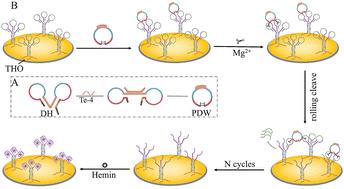伪环状DNA walker介导的载脂蛋白E4基因敏感检测电化学生物传感器
IF 4.2
2区 化学
Q2 CHEMISTRY, MULTIDISCIPLINARY
引用次数: 0
摘要
在这项工作中,我们报道了一个伪环形DNA行走器(PDW)与g -四重体(G4)和三重体DNA集成,构建电化学生物传感器,用于超灵敏检测载脂蛋白E4 (ApoE4)。PDW包含双嵌入DNAzyme序列,利用其固有的优势,增强结构刚度以稳定的空间构象,连续自主滚动能力,以及发夹探针由于其闭环拓扑结构而有效的循环解理。PDW与靶标结合后,激活其催化结构域,在Mg2+存在下滚动、切割发夹探针。三螺旋结构作为固定发夹DNA探针的刚性支架,增强了界面稳定性和信号探针的负载效率。裂解释放出富含g的DNA片段,这些片段随后自组装成血红蛋白/ g四重体(HG4)纳米结构。该设计实现了无标签检测,具有卓越的灵敏度,线性范围为0.05-10 pM,检测极限为27 fM。该策略为神经退行性疾病生物标志物的灵敏检测开辟了一条新途径,在疾病早期筛查和临床监测领域具有广阔的应用前景。本文章由计算机程序翻译,如有差异,请以英文原文为准。

A pseudo-circular DNA walker-mediated electrochemical biosensor for sensitive detection of the apolipoprotein E4 gene
In this work, we report a pseudo-circular DNA walker (PDW) integrated with G-quadruplex (G4) and triplex DNA to construct an electrochemical biosensor for ultrasensitive detection of apolipoprotein E4 (T-e4). PDW contains double embedded DNAzyme sequences, leveraging the intrinsic advantages of enhanced structural rigidity for stable spatial conformation, continuous autonomous rolling capability, and efficient cyclic cleavage of hairpin probes due to its closed-loop topology. After binding to the target, the catalytic domain of the PDW is activated, rolling and cutting the hairpin probe in the presence of Mg2+. The triplex helix hairpin orbital (THO) serves as a rigid scaffold to immobilize hairpin DNA probes, enhancing interfacial stability and signal probe loading efficiency. The cleavage releases G-rich DNA fragments, which subsequently self-assemble into hemin/G-quadruplex (HG4) nanostructures. This design achieves label-free detection with exceptional sensitivity, exhibiting a linear range of 0.05–10 pM and a detection limit of 27 fM. This strategy opens up a new way for the sensitive detection of neurodegenerative disease biomarkers and shows broad application prospects in the fields of early disease screening and clinical monitoring.
求助全文
通过发布文献求助,成功后即可免费获取论文全文。
去求助
来源期刊

Chemical Communications
化学-化学综合
CiteScore
8.60
自引率
4.10%
发文量
2705
审稿时长
1.4 months
期刊介绍:
ChemComm (Chemical Communications) is renowned as the fastest publisher of articles providing information on new avenues of research, drawn from all the world''s major areas of chemical research.
 求助内容:
求助内容: 应助结果提醒方式:
应助结果提醒方式:


